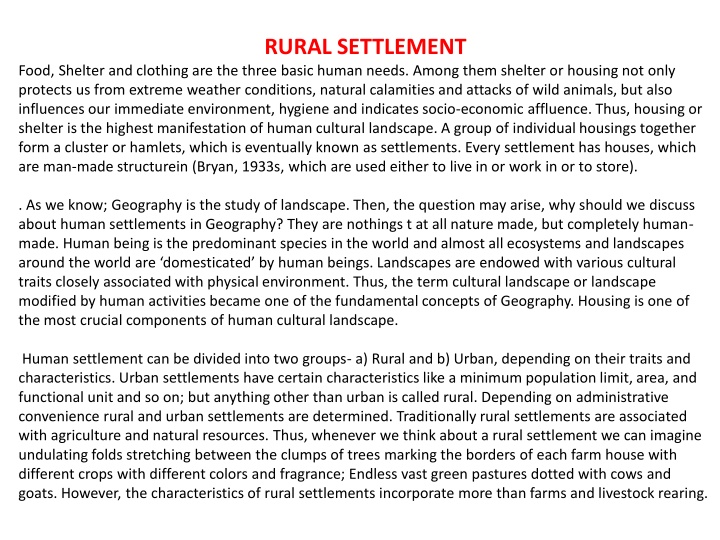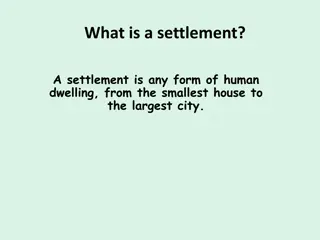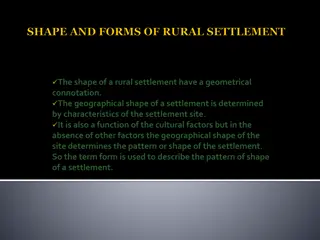
Rural Settlements: Characteristics and Importance
Learn about rural settlements, where housing plays a crucial role in human survival and cultural landscape. Discover the nature, characteristics, and significance of rural settlements, distinguishing them from urban areas based on population size, density, and economic activities. Explore how site selection factors like physical, climatic, economic, and traditional influences shape these settlements, with a focus on agriculture and community dynamics.
Download Presentation

Please find below an Image/Link to download the presentation.
The content on the website is provided AS IS for your information and personal use only. It may not be sold, licensed, or shared on other websites without obtaining consent from the author. If you encounter any issues during the download, it is possible that the publisher has removed the file from their server.
You are allowed to download the files provided on this website for personal or commercial use, subject to the condition that they are used lawfully. All files are the property of their respective owners.
The content on the website is provided AS IS for your information and personal use only. It may not be sold, licensed, or shared on other websites without obtaining consent from the author.
E N D
Presentation Transcript
RURAL SETTLEMENT Food, Shelter and clothing are the three basic human needs. Among them shelter or housing not only protects us from extreme weather conditions, natural calamities and attacks of wild animals, but also influences our immediate environment, hygiene and indicates socio-economic affluence. Thus, housing or shelter is the highest manifestation of human cultural landscape. A group of individual housings together form a cluster or hamlets, which is eventually known as settlements. Every settlement has houses, which are man-made structurein (Bryan, 1933s, which are used either to live in or work in or to store). . As we know; Geography is the study of landscape. Then, the question may arise, why should we discuss about human settlements in Geography? They are nothings t at all nature made, but completely human- made. Human being is the predominant species in the world and almost all ecosystems and landscapes around the world are domesticated by human beings. Landscapes are endowed with various cultural traits closely associated with physical environment. Thus, the term cultural landscape or landscape modified by human activities became one of the fundamental concepts of Geography. Housing is one of the most crucial components of human cultural landscape. Human settlement can be divided into two groups- a) Rural and b) Urban, depending on their traits and characteristics. Urban settlements have certain characteristics like a minimum population limit, area, and functional unit and so on; but anything other than urban is called rural. Depending on administrative convenience rural and urban settlements are determined. Traditionally rural settlements are associated with agriculture and natural resources. Thus, whenever we think about a rural settlement we can imagine undulating folds stretching between the clumps of trees marking the borders of each farm house with different crops with different colors and fragrance; Endless vast green pastures dotted with cows and goats. However, the characteristics of rural settlements incorporate more than farms and livestock rearing.
NATURE AND CHARACTERISTICS OF RURAL SETTLEMENTS Population size and density are the most important characteristics that categorize a settlement either as rural or as urban. The Census of India defines a settlement with minimum 5000 population, and 400 people per sq.km density; and, at least 75 percent of male working population engaged in non-agricultural pursuits as urban. Rest are classified as rural settlements. So, three important characteristics are associated with rural settlements a) low population size b) low density of population and c) agriculture as the main economic activity of people. Apart from agriculture, other primary activities like fishing, animal husbandry, mining and quarrying, forest product collection etc. can be the main occupations of the inhabitants. Thus, rural settlements have closer contact with the nature. d) Village community displays homogeneity in culture and occupation is mainly hereditary creating social strata known as caste. There is low scope for social mobility. Strong community bonding with joint and extended family system are prevalent here. Site and Situation The words site and situation are two important determining factors, they are not synonymous, but different. Site means the place where a particular settlement is located. Site of a settlement is indicated through latitude, longitude etc. Selection of a site is governed by suitable physical and climatic conditions. A. Site Factors Site factors can be clubbed into four broad headings- 1.Physical, 2. Climatic, 3. Economic, and 4. Traditional. Let us discuss each factors briefly.
In South-East Asia villages are located near rivers and water bodies, because paddy cultivation needs water. d) Water- Though water is essential for survival but excessive water is not good. Therefore, water related sites are of two types- i) Wet point and ii) dry point. i. Wet Point- In dry climate settlements are found near water points and at ground level. In desert areas, settlement sprung up near oasis or springs. There are following wet point sites 1. River confluence site 2. River Bend site 3. Stream side 4. Fording point 5. River island 6. Coastal side 7. Delta site 8. Canal and well side ii. Dry point- In humid region settlements are found in natural levees (Kolkata for example, situated on a natural levee). 2) Climatic Factors a) Ground water b) River/ canal c) Rainfall d) Humidity, temperature 3) Economic Factors a) Resources like minerals, food, oil etc offer good sites of settlements. California and San Francisco sprung up after discovery of gold mines. In India, Jhariya, Jarsuguda etc are mining town. b) Nodal points- Route centres are nodal points to offer good connectivity. Settlements grow where two valleys meet or roads connect each other. Therefore, nodal points can be transport points. Example- Railway junction- Mughalsarai.
4) Traditional Factors Before the age of democracy constant warfare and looting compelled human beings to stay together within fortified settlements. Therefore forts offered safety. Even today remnants of fortified settlements are abundant in the world. These forts and castles are often located at strategic points like hill top, cliffs etc. Jaisalmere fort of Rajasthan is one of the few living fort of Asia. a) Defense- Medieval castles and settlements were built up on hills or cliffs. Edinburgh castle is situated on glacial crag. Ditch or rivers also offer defense. In the late 18th century (1742), Maratha Ditch was constructed around Calcutta and it protected city dwellers from Maratha invasion. People started living near Fort William. Structure and Morphology of Rural Settlement b) Bridging point means confluence of two rivers, and river crossing-ideal for waterway development-Khartoum on Nile River. During earlier days rivers offered cheap and fastest transportation. Therefore, riverine ports offered good settlement sites. In India, Saptagram, Tamralipta etc were port settlements. c) Cultural factors like temples, mosque, church, universities etc also offer settlement sites. Varanasi, Ujjain etc are temple towns. However, cultural and economic factors alone cannot play role here. Multiple factors determine settlement sites. B. Situation There is a close relationship between site and its immediate physical environment. A settlement can be described in relation to other settlements and physical features around it. It is generally linked up with physical and cultural conditions of a much wider area. The main factor that influences situation of a settlement is its accessibility or centrality.






















